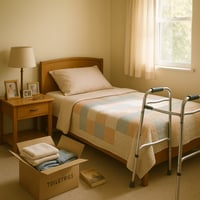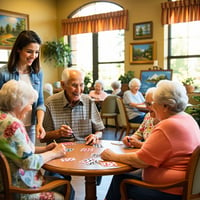💬 Introduction: The First Step Toward a New Chapter Moving into an assisted living community is a...
How Art Therapy Inspires Joy, Memory, and Meaning in Assisted Living
Table of Contents
Why Art Therapy Matters in Senior Living
Aging may change how we move through the world—but it doesn’t dull the spark of creativity within us. In fact, creative expression becomes even more powerful as we grow older, offering a path to memory, healing, and connection.
In assisted living communities, art therapy is more than just painting a picture—it’s a tool for enhancing quality of life, nurturing emotional resilience, and keeping the mind and spirit engaged.
"Art enables us to find ourselves and lose ourselves at the same time."
— Thomas Merton
Understanding Art Therapy for Older Adults
Art therapy uses creative expression—like drawing, painting, sculpting, and collage-making—as a way to support emotional, mental, and physical well-being. It's practiced in both clinical and community-based settings and is especially meaningful for older adults navigating cognitive changes or life transitions.
According to the American Art Therapy Association, art therapy in senior care can:
-
Improve memory and cognitive flexibility
-
Reduce anxiety, depression, and agitation
-
Help process grief or change
-
Enhance motor skills and dexterity
-
Restore a sense of identity and autonomy
No art experience is needed. What matters is the process—not the product.
5 Lasting Benefits of Art Therapy for Seniors
1. Cognitive Engagement
Engaging in art activates multiple areas of the brain, encouraging new neural connections. It’s particularly effective for individuals with Alzheimer’s or dementia, helping stimulate memory recall and attention.
Studies show that structured art-making may slow cognitive decline and support memory retention in seniors with mild to moderate dementia.
2. Emotional Healing
Color, texture, and form provide powerful outlets for emotional expression—especially for those who may struggle to communicate verbally.
3. Stress Reduction
Creating art promotes relaxation and mindfulness. Even short sessions can lower cortisol levels, decrease heart rate, and create a sense of calm.
4. Motor Skill Support
Holding a paintbrush, folding paper, or molding clay improves hand strength and coordination—beneficial for seniors managing arthritis or recovering from stroke.
5. Social Connection
Group art sessions foster community. Conversations spark naturally as residents share their work, memories, and experiences. These moments combat loneliness and build confidence.
Real-Life Inspiration from Creative Aging Programs
At Sarawood, and in many like-minded assisted living communities, art programs are designed to be inclusive, joyful, and resident-driven. Here’s how creative aging looks in practice:
-
Memory Portraits: Residents illustrate personal milestones like their first home, a childhood pet, or a favorite family tradition. These projects often spark meaningful stories during and after sessions.
-
Resident Art Shows: Periodically, residents’ artwork is displayed in gallery-style exhibits, offering family members a chance to see their loved one’s creativity on full display.
-
Seasonal Workshops: Guided classes follow themes like “Autumn Reflections” or “A Winter of Memories,” incorporating music, poetry, and sensory experiences alongside visual art.
“I didn’t realize how much I missed this until I sat down and picked up a brush again,” said one resident. “Now I look forward to it every week.”
How Families Can Encourage Creativity at Home
Whether your loved one lives independently, with family, or in a care setting, art can be introduced at any time and adapted for any ability level.
✅ At-Home Creative Aging Tips
-
Use easy-grip tools like jumbo markers, soft pastels, or watercolor pencils
-
Start with short sessions (20–30 minutes) and encourage without pressure
-
Offer prompts like: “Paint your favorite meal,” or “Draw a place that makes you feel peaceful”
-
Celebrate every effort—hang artwork on the fridge, frame it, or mail it to friends
-
Explore intergenerational projects with grandchildren
Want to get started?
Download our free guide to Simple Art Projects for Aging Parents (PDF)
Closing Thoughts: The Power of Creative Expression in Aging
Art therapy isn’t just about making something beautiful—it’s about discovering something meaningful. For older adults, the simple act of creating can awaken memories, ease loneliness, and remind them—and us—of the unique story they still have to tell.
Whether through color, shape, or shared silence, art helps our residents feel seen and heard.
At Sarawood, we believe that creativity is not limited by age—it’s liberated by it.
💚 Closer Connections, Better Care.
Further Resources
See How Creative Care Comes to Life
If you're beginning to explore care options for your parent, partner, or loved one, you're not alone—and you're asking the right questions. Programs like art therapy may seem simple, but they often have the most profound impact: sparking joy, lifting spirits, and bringing meaning to each day.
At Sarawood, we believe that creativity, connection, and compassionate care go hand in hand. If you'd like to learn more about how enrichment activities like art therapy support emotional and cognitive well-being, we invite you to:
-
📞 Schedule a private call or tour to speak with our care team
-
📘 Browse our FAQ to better understand what daily life looks like in our close-knit community
We're here when you're ready—no pressure, just a conversation.
💚 Closer Connections, Better Care.



